Building Damage Estimation by Integration of Seismic Intensity Information and Satellite L-band SAR Imagery
Abstract
:1. Introduction
2. Likelihood Function from JERS-1/SAR
2.1. SAR Images and Ground Truth Data
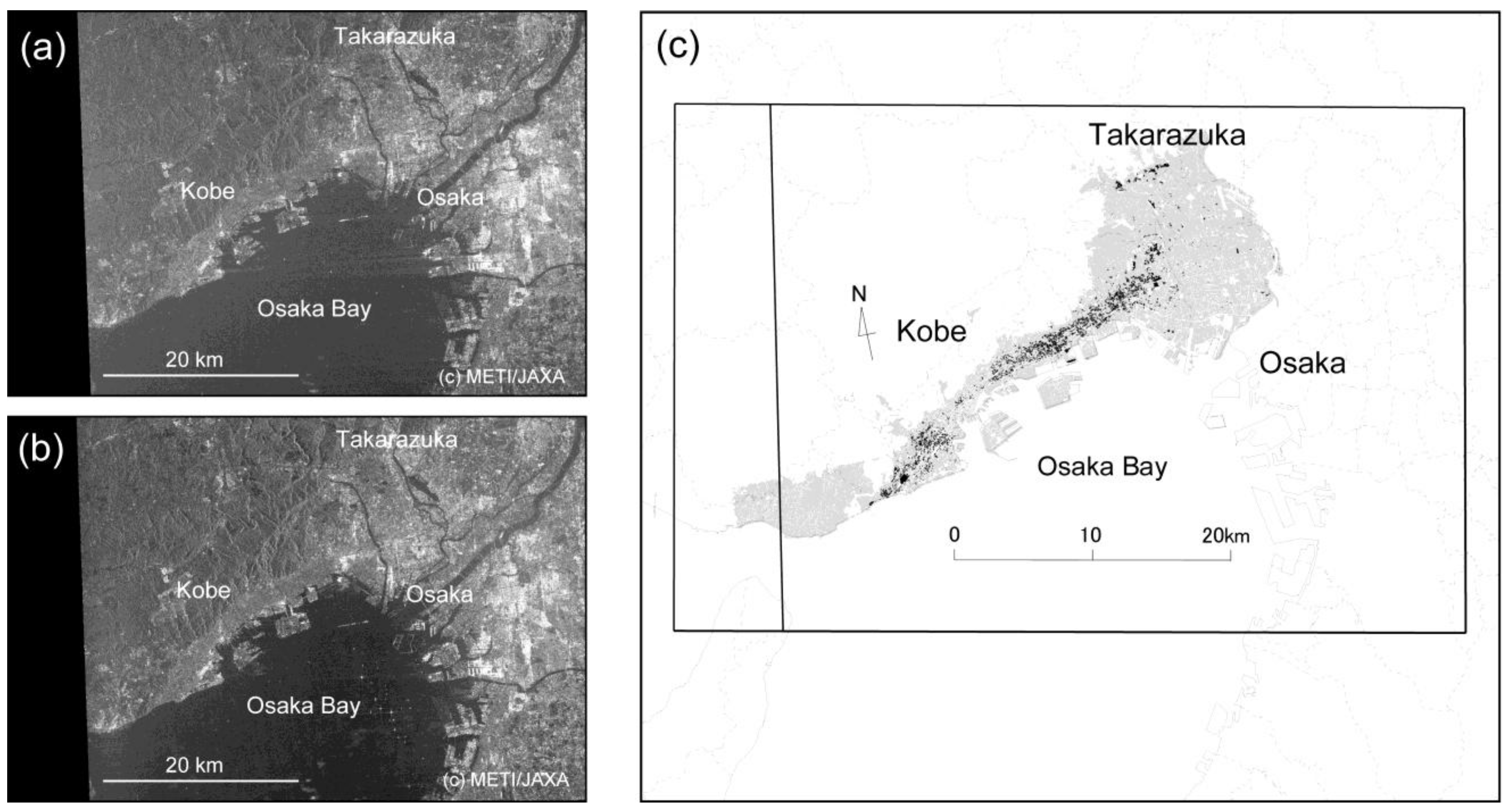
2.2. Derivation of Regression Discriminant Function and Likelihood Function
| Damage Rank | Severe Damage Ratio D (%) | Mid-value (%) |
|---|---|---|
| θ1 | D = 0 | 0.0 |
| θ2 | 0.0 < D < 6.25 | 3.13 |
| θ3 | 6.25 ≦ D < 12.5 | 9.38 |
| θ4 | 12.5 ≦ D < 25 | 18.75 |
| θ5 | 25 ≦ D < 50 | 37.5 |
| θ6 | 50 ≦ D < 100 | 75.0 |
| θ7 | D = 100 | 100.0 |
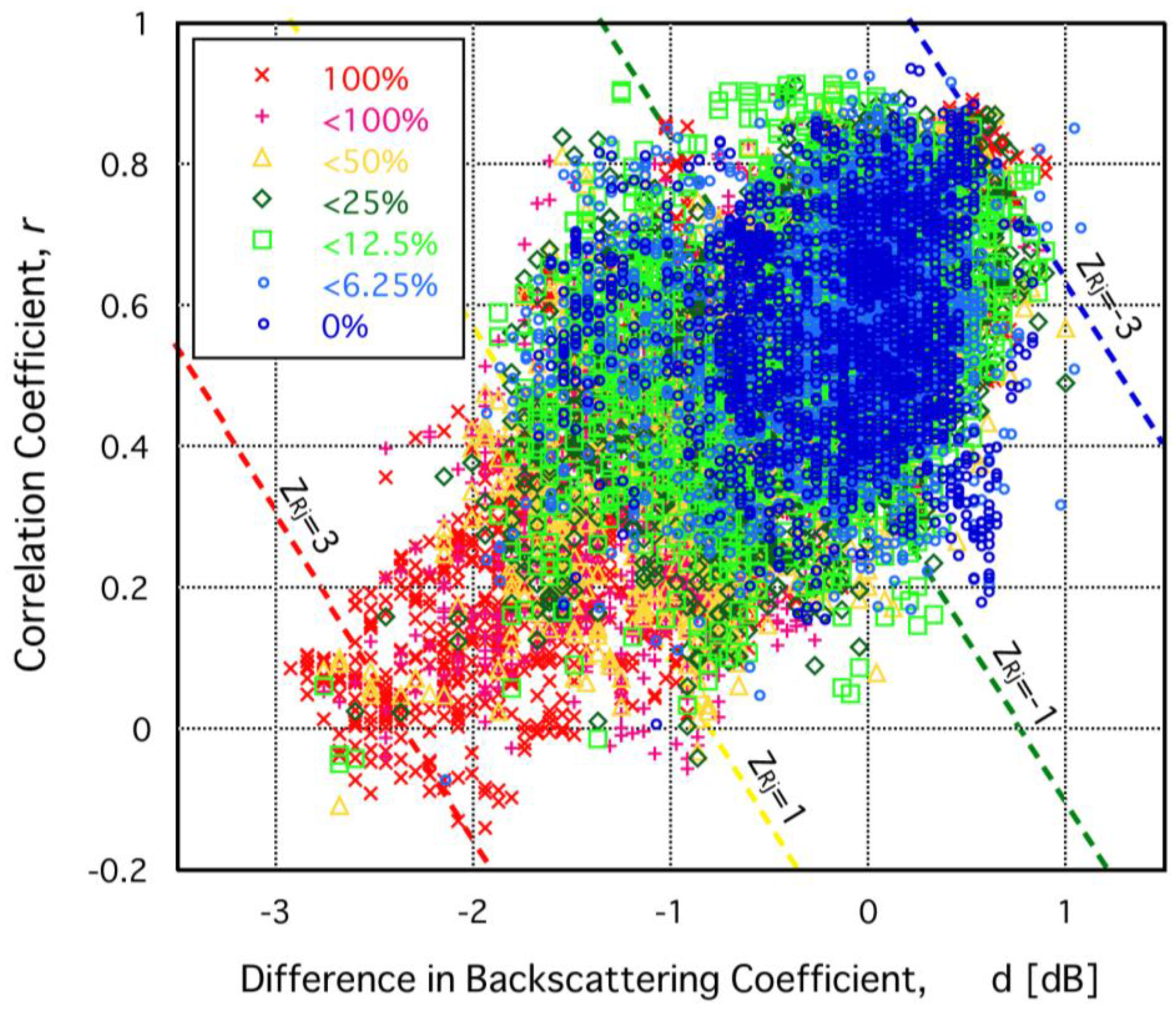
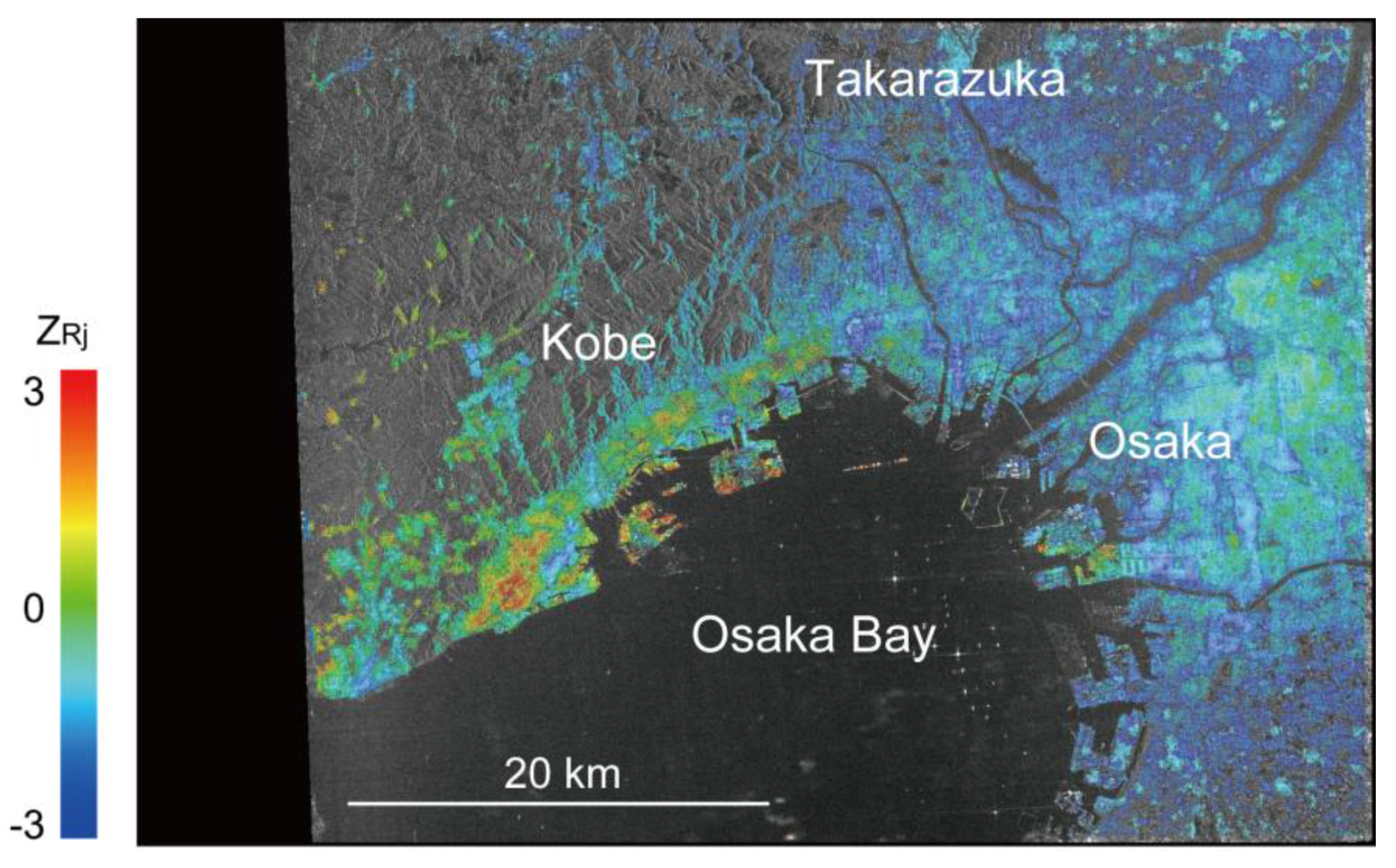
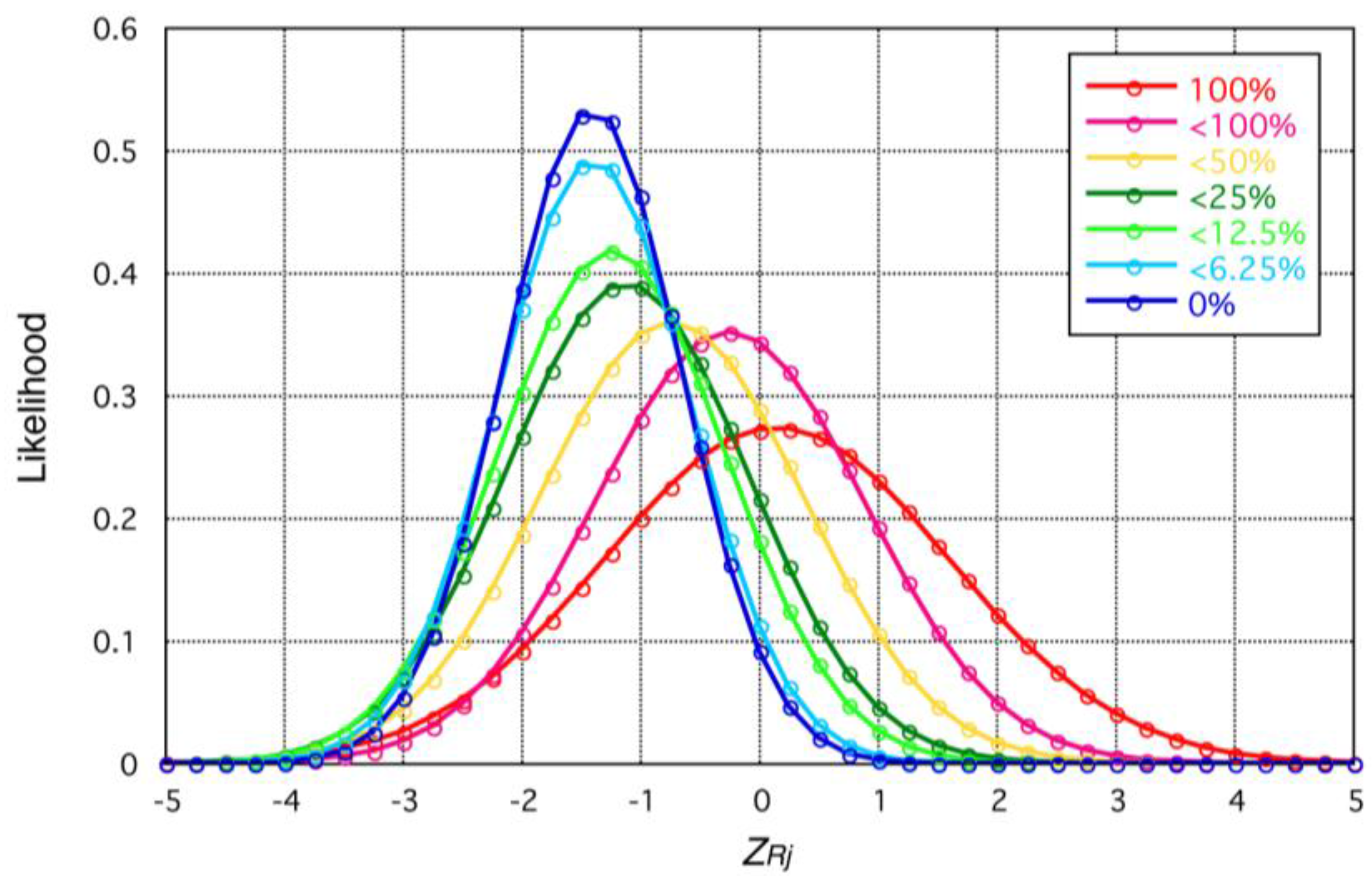
| Damage Rank | Average of ZRj | Standard Deviation |
|---|---|---|
| θ1 | −1.399 | 0.747 |
| θ2 | −1.390 | 0.809 |
| θ3 | −1.233 | 0.955 |
| θ4 | −1.110 | 1.018 |
| θ5 | −0.733 | 1.107 |
| θ6 | −0.241 | 1.134 |
| θ7 | 0.151 | 1.457 |
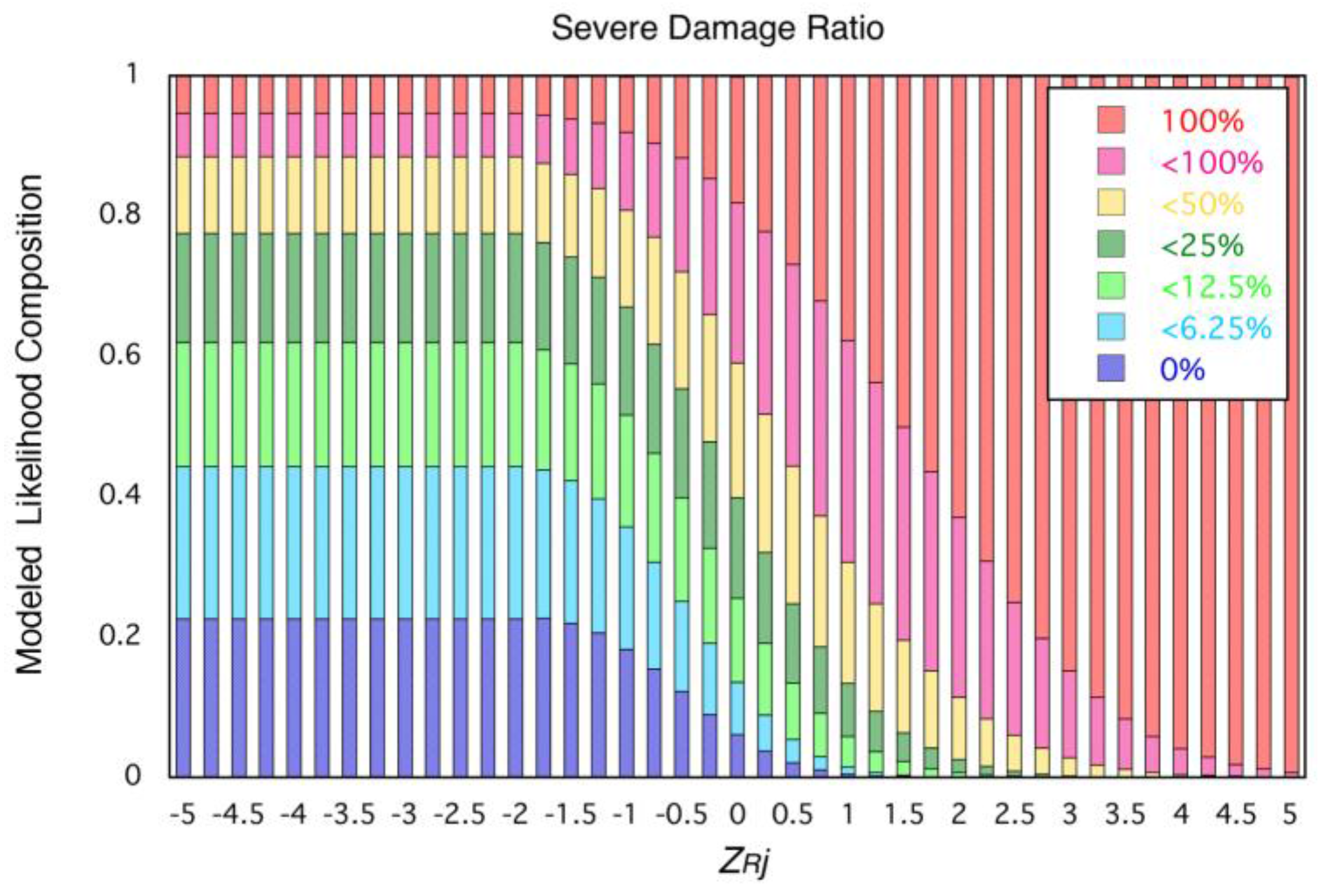

3. Damage Ratio Estimation by Integration with Seismic Intensity Information
3.1. Integration of SAR Images and Seismic Intensity Information
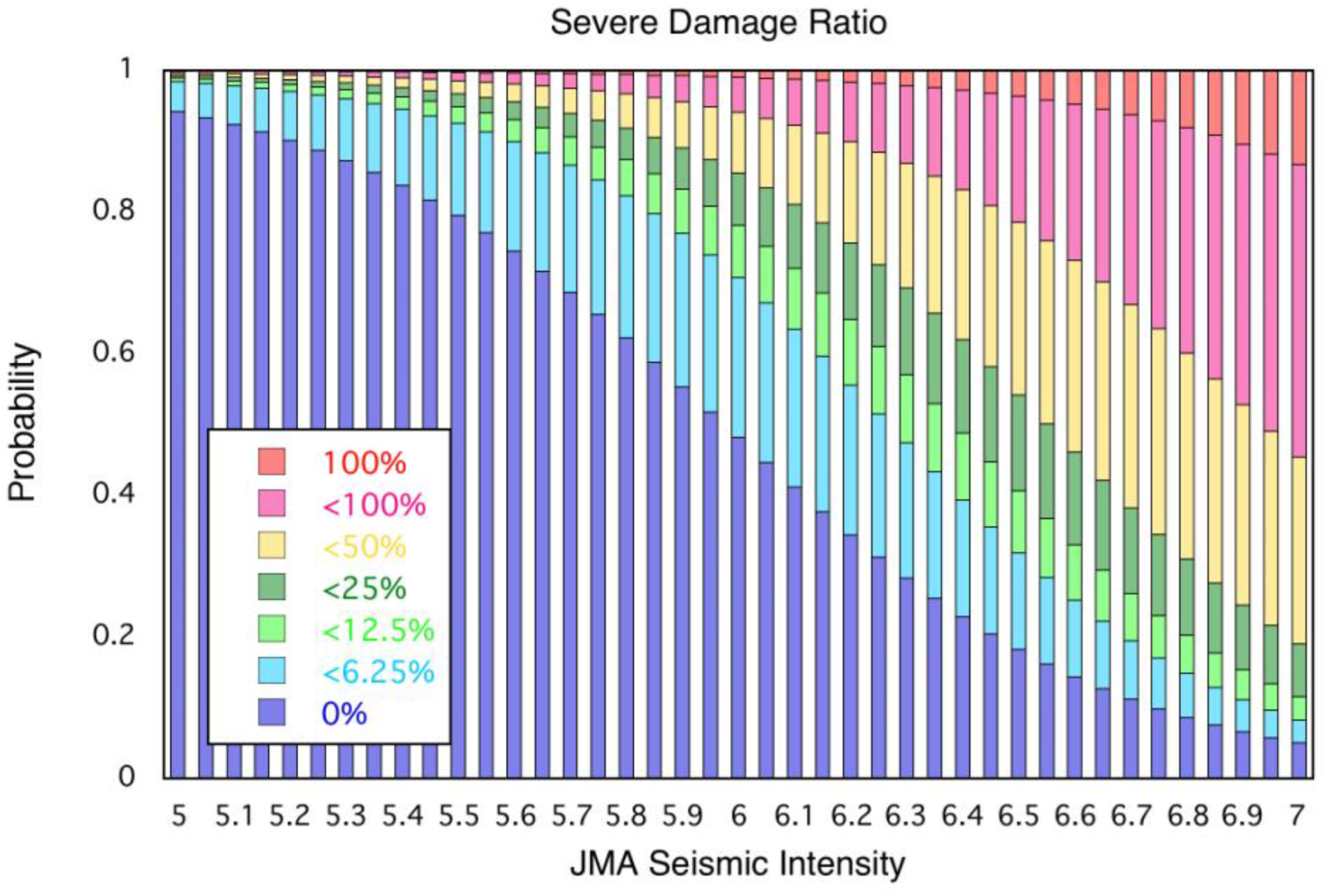
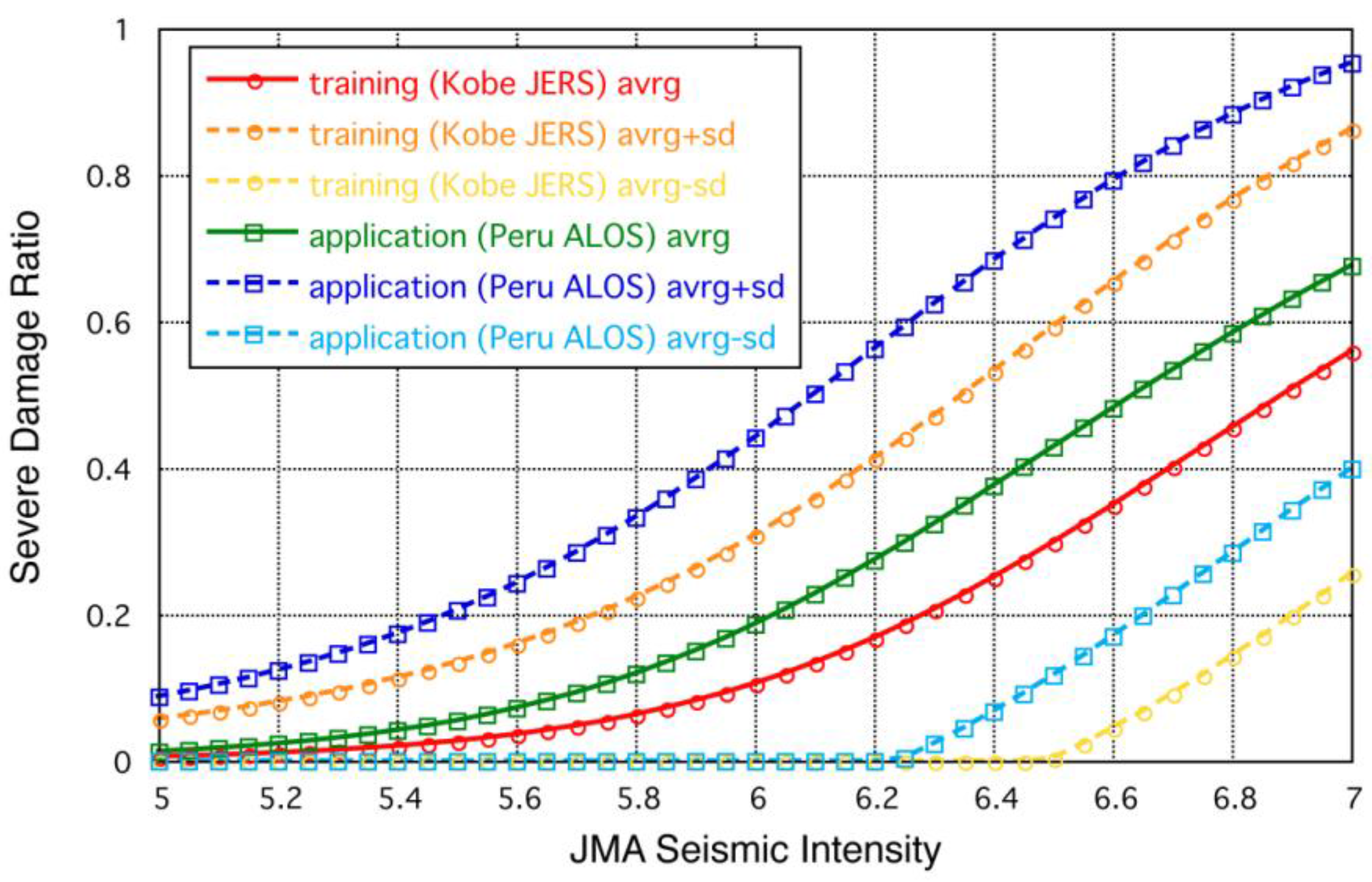
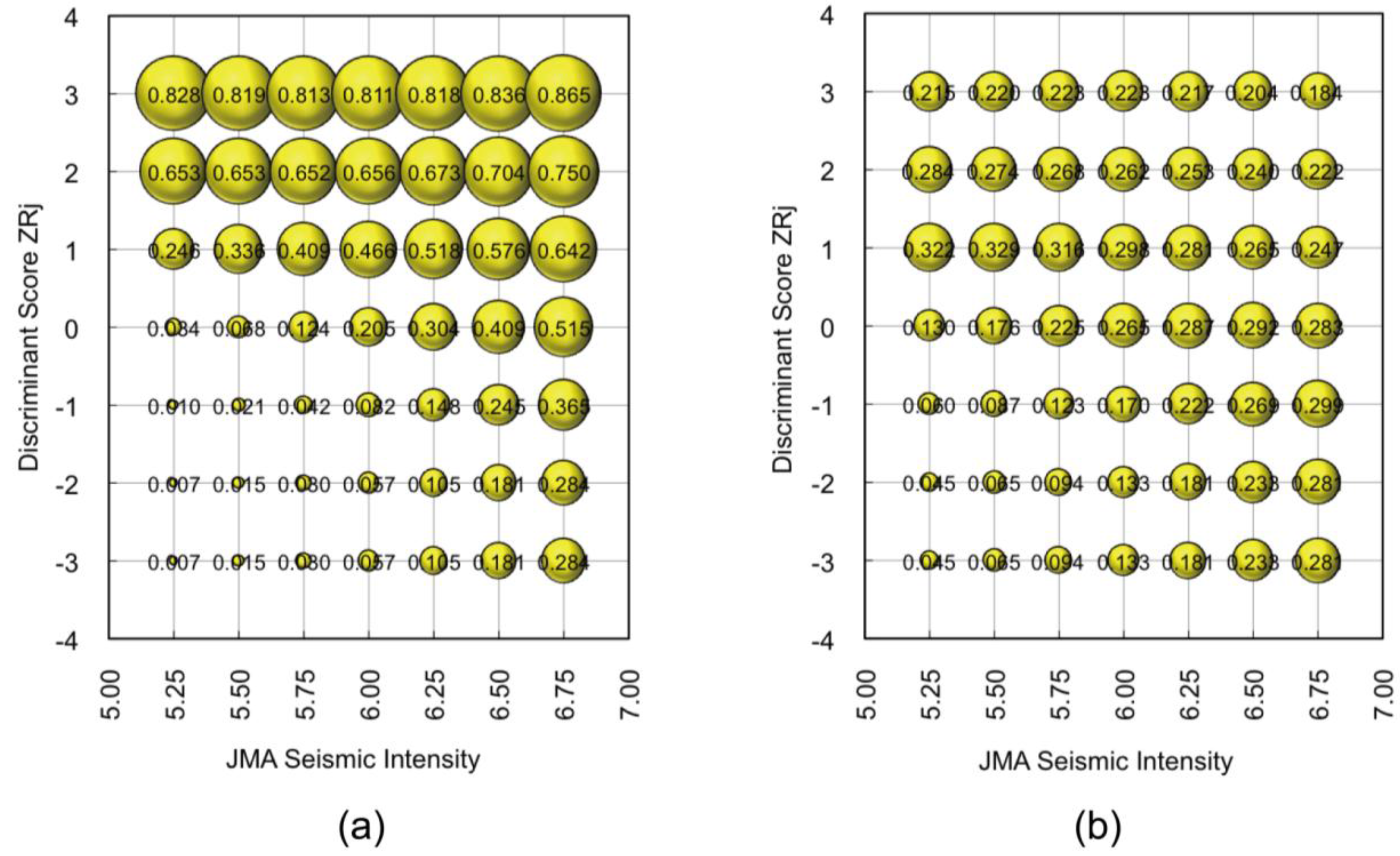
3.2. Estimation of Severe Damage Ratio in the Kobe Earthquake
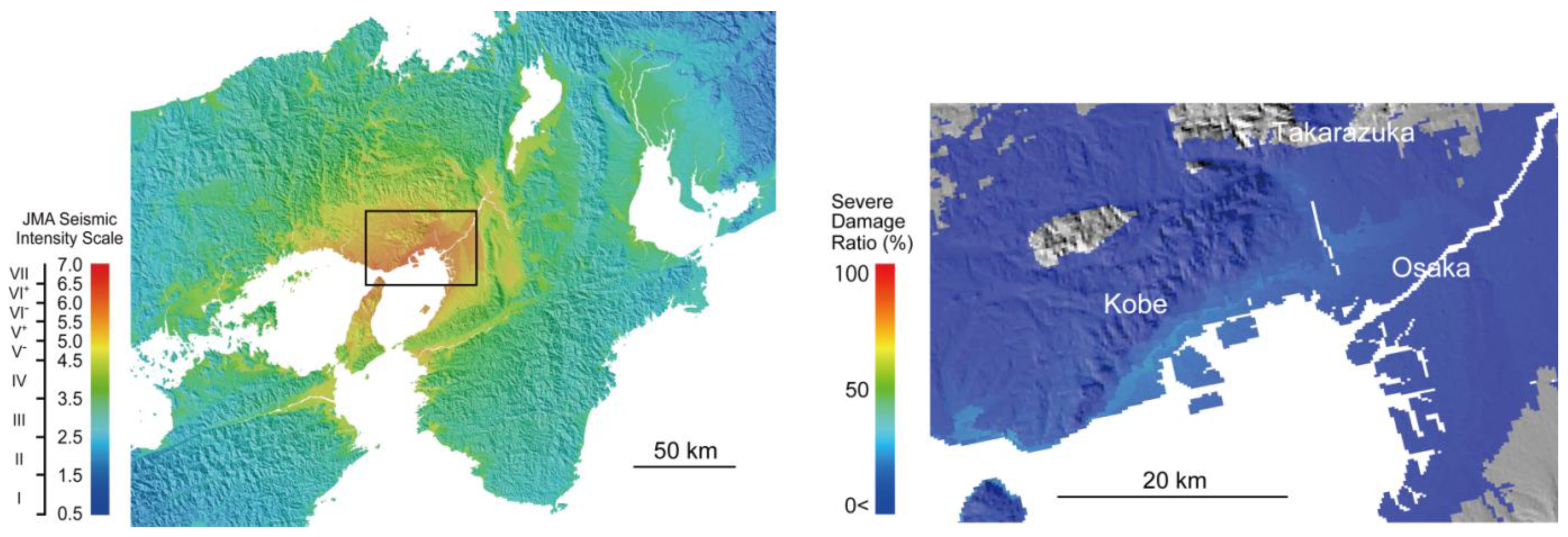
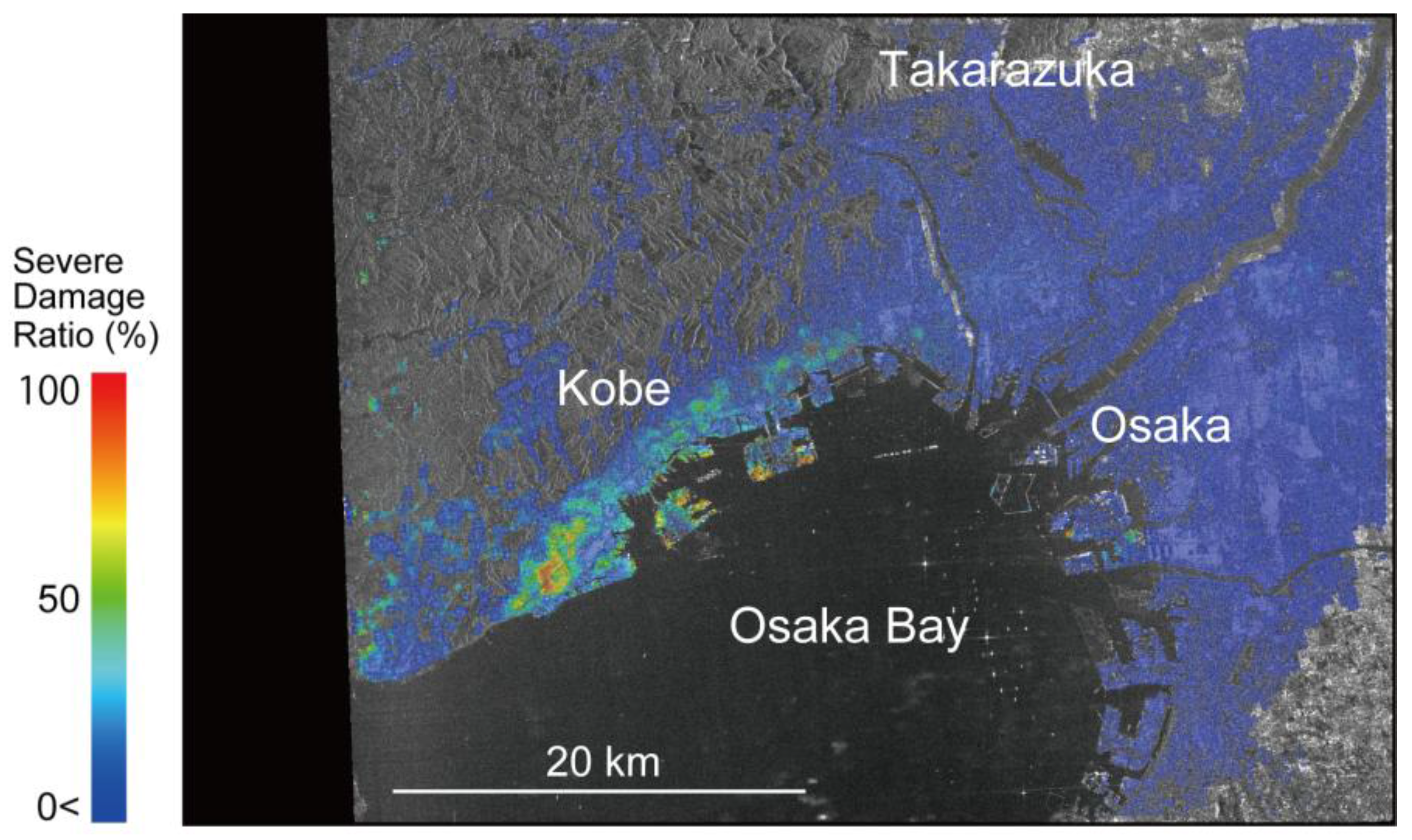
4. Application to ALOS/PALSAR Images of the 2007 Peru Earthquake
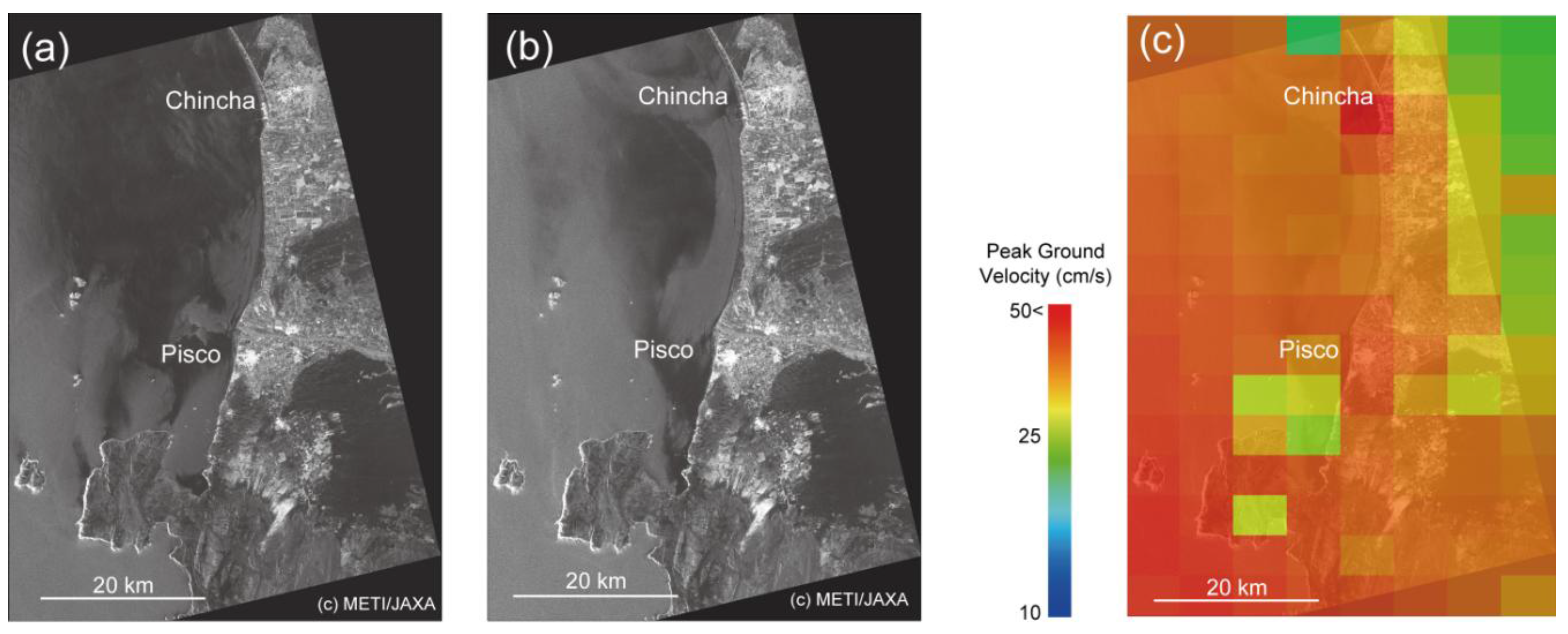

5. Conclusions
Acknowledgements
References and Notes
- Yamazaki, F.; Yano, Y.; Matsuoka, M. Visual damage interpretation of buildings in Bam city using QuickBird images following the 2003 Bam, Iran, earthquake. Earthq. Spectra 2005, 21, S329–S336. [Google Scholar] [CrossRef]
- Gusella, L.; Adams, B.J.; Bitelli, G.; Huyck, C.K.; Mognola, A. Object-oriented image understanding and post-earthquake damage assessment for the 2003 Bam, Iran, earthquake. Earthq. Spectra 2005, 21, S225–S238. [Google Scholar] [CrossRef]
- Miura, H.; Midorikawa, S. Detection of slope failure areas due to the 2004 Niigata-ken Chuetsu earthquake using high-resolution satellite images and digital elevation model. J. Jpn. Assoc. Earthq. Eng. 2007, 7, 1–14, (in Japanese with English abstract). [Google Scholar] [CrossRef]
- Massonnet, D.; Rossi, M.; Carmona, C.; Adragna, F.; Peltzer, G.; Fiegl, K.; Rabaute, T. The displacement field of the Landers earthquake mapped by radar interferometry. Nature 1993, 364, 138–142. [Google Scholar] [CrossRef]
- Hao, K.X.; Si, H.; Fujiwara, H.; Ozawa, T. Coseismic surface-ruptures and crustal deformations of the 2008 Wenchuan earthquake Mw7.9, China. Geophys. Res. Lett. 2009, 36, L11303. [Google Scholar] [CrossRef]
- Aoki, H.; Matsuoka, M.; Yamazaki, F. Characteristics of satellite SAR images in the damaged areas due to the Hyogoken-nanbu earthquake. In Proceedings of 19th Asian Conference on Remote Sensing, Manila, Philippines, November 1998; C7. pp. 1–6.
- Matsuoka, M.; Yamazaki, F. Interferometric characterization of areas damaged by the 1995 Kobe earthquake using satellite SAR images. In Proceedings of 12th World Conference on Earthquake Engineering, Auckland, New Zealand, January 2000. CD-ROM, Paper ID 2141.
- Yonezawa, C.; Takeuchi, S. Decorrelation of SAR data by urban damages caused by the 1995 Hyogoken-nanbu earthquake. Int. J. Remote Sens. 2001, 22, 1585–1600. [Google Scholar] [CrossRef]
- Ito, Y.; Hosokawa, M.; Matsuoka, M. A degree estimation model of earthquake damage using temporal coherence ratio. In Proceedings of International Geoscience and Remote Sensing Symposium, Toulouse, France, July 2003; CD-ROM. p. 3.
- Hosokawa, M.; Jeong, B.; Takizawa, O.; Matsuoka, M. Disaster risk evaluation and damage detection using remote sensing data for global rescue operations. In Proceedings of Commission VIII ISPRS Congress, Beijing, China, July 2008; Available online: http://www.isprs.org/proceedings/XXXVII/congress/8_pdf/2_WG-VIII-2/06.pdf (accessed on 18 May 2010).
- Matsuoka, M.; Yamazaki, F. Use of satellite SAR intensity imagery for detecting building areas damaged due to earthquakes. Earthq. Spectra 2004, 20, 975–994. [Google Scholar] [CrossRef]
- Nojima, N.; Matsuoka, M.; Sugito, M.; Ezaki, K. Quantitative estimation of building damage based on data integration of seismic intensities and satellite SAR imagery. J. Struct. Mech. Earthq. Eng. 2006, 62, 808–821, (in Japanese with English abstract). [Google Scholar] [CrossRef]
- Matsuoka, M.; Yamazaki, F. Application of the damage detection method using SAR intensity images to recent earthquakes. In Proceedings of International Geoscience and Remote Sensing Symposium, Toronto, ON, Canada, June 2002; CD-ROM. p. 3.
- Final Damage Report of the 1995 Hyogo-ken Nanbu Earthquake; Building Research Institute: Tsukuba, Japan, 1996; [CD-ROM]; p. 303. (in Japanese)
- Grünthal, G. European Macroseismic Scale (EMS-98); European Seismological Commission: Luxembourg, Belgium, 1998; p. 99. [Google Scholar]
- Lee, J.S. Digital image enhancement and noise filtering by use of local statistics. IEEE Trans. Patt. Anal. Mach. Int. 1980, 2, 165–168. [Google Scholar] [CrossRef]
- Okuno, T.; Kume, H.; Haga, T.; Yoshizawa, T. Multivariate Statistical Methods; Union of Japanese Scientists and Engineers: Tokyo, Japan, 1981; pp. 259–321. (in Japanese) [Google Scholar]
- Wald, D.J. Slip history of the 1995 Kobe, Japan, earthquake determined from strong motion, teleseismic and geodetic data. J. Phys. Earth 1996, 44, 489–503. [Google Scholar] [CrossRef]
- Si, H.; Midorikawa, S. New attenuation relations for peak ground acceleration and velocity considering effects of fault type and site condition. In Proceedings of 12th World Conference on Earthquake Engineering, Auckland, New Zealand, January 2000. [CD-ROM], Paper ID 532.
- Matsuoka, M.; Wakamatsu, K.; Fujimoto, K.; Midorikawa, S. Average shear-wave velocity napping using Japan Engineering Geomorphologic Classification Map. J. Struct. Eng. Earthq. Eng. 2006, 23, 57s–68s. [Google Scholar]
- Wakamatsu, K.; Matsuoka, M. Development of the 7.5-arc-second engineering geomorphologic classification database and its application to seismic microzoning. Bull. Earthq. Res. Inst. 2006, 81, 317–324. [Google Scholar]
- Wakamatsu, K.; Kubo, S.; Matsuoka, M.; Hasegawa, K.; Sugiura, M. Japan Engineering Geomorphologic Classification Map; University of Tokyo Press: Tokyo, Japan, 2005; p. 112, (in Japanese with English abstract, GIS data in CD-ROM). [Google Scholar]
- Fujimoto, K.; Midorikawa, S. Empirical estimates of site amplification factor from strong-motion records at nearby station pairs. In Proceedings of the 1st European Conference on Earthquake Engineering and Seismology, Geneva, Switzerland, September 2006. [CD-ROM], Paper No.251.
- Fujimoto, K.; Midorikawa, S. Empirical method for estimating J.M.A. instrumental seismic intensity from ground motion parameters using strong motion records during recent major earthquakes. J. Inst. Social Safety Sci. 2005, 7, 214–246, (in Japanese with English abstract). [Google Scholar]
- Wald, D.J.; Worden, B.C.; Quitoriano, V.; Pankow, K.L. ShakeMap Manual: Technical Manual, User’s Guide, and Software Guide Ver. 1.0; Techniques and Methods 12-A1; US Geological Survey: Golden, CO, USA, 2006; p. 156.
- ShakeMap; U.S. Geological Survey: Golden, CO, USA. Available online: http://earthquake.usgs.gov/eqcenter/shakemap/ (access on 1 June 2009).
- PAGER: Prompt Assessment of Global Earthquakes for Response; U.S. Geological Survey: Golden, CO, USA. Available online: http://earthquake.usgs.gov/eqcenter/pager/ (access on 1 June 2009).
- Coburn, A.; Spence, R. Earthquake Protection. In Earthquake Risk Modeling; John Wiley & Sons: West Sussex, UK, 2002; p. 436. [Google Scholar]
- O’Rourke, T.D.; Sang-Soo, J.; Eguchi, R.T.; Huyck, C.K. Advanced GIS for loss estimation and rapid post-earthquake assessment of building damage. In Research Progress and Accomplishment; Multidisciplinary Center for Earthquake Engineering Research: Buffalo, NY, USA, 2000; pp. 157–164. [Google Scholar]
- ShakeMap us2007gbcv; U.S. Geological Survey: Golden, CO, USA. Available online: http://earthquake.usgs.gov/eqcenter/shakemap/global/shake/2007gbcv/ (access on 1 June 2009).
- Estrada, M.; Zavala, C.; Aguilar, Z. Damage study of the Pisco, Peru earthquake using GIS and satellite images. In Proceedings of International Workshop for Safer Housing in Indonesia and Peru, Tsukuba, Japan, March 2008.
- Matsuoka, M.; Horie, K.; Ohkura, H. Damage detection for the 2004 Niigata-ken Chuetsu earthquake using satellite SAR. In Proceedings of SPIE (Asia-Pacific Remote Sensing Symposium, Disaster Forewarning Diagnostic Methods and Management), Goa, India, November 2006; Vol.6412, ID64120M. p. 10.
- Jaiswal, K.; Wald, D.J. Creating A Global Building Inventory for Earthquake Loss Assessment and Risk Management; Open-file Report 2008-1160; U.S. Geological Survey: Golden, CO, USA, 2008; p. 103.
© 2010 by the authors; licensee MDPI, Basel, Switzerland. This article is an open access article distributed under the terms and conditions of the Creative Commons Attribution license (http://creativecommons.org/licenses/by/3.0/).
Share and Cite
Matsuoka, M.; Nojima, N. Building Damage Estimation by Integration of Seismic Intensity Information and Satellite L-band SAR Imagery. Remote Sens. 2010, 2, 2111-2126. https://doi.org/10.3390/rs2092111
Matsuoka M, Nojima N. Building Damage Estimation by Integration of Seismic Intensity Information and Satellite L-band SAR Imagery. Remote Sensing. 2010; 2(9):2111-2126. https://doi.org/10.3390/rs2092111
Chicago/Turabian StyleMatsuoka, Masashi, and Nobuoto Nojima. 2010. "Building Damage Estimation by Integration of Seismic Intensity Information and Satellite L-band SAR Imagery" Remote Sensing 2, no. 9: 2111-2126. https://doi.org/10.3390/rs2092111





